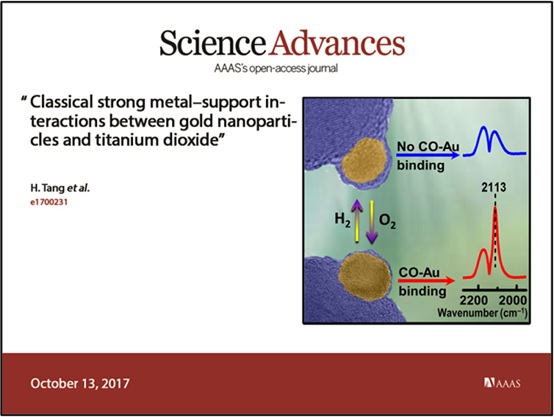Researchers in MEDC has discovered the strong metal-support interaction (SMSI) between Au nanoparticles (NPs) and titania for the first time. This work is now online published in Science Advances (Science Advances, 2017, 3 : e1700231, http://advances.sciencemag.org/content/3/10/e1700231).
Strong metal-support interaction (SMSI; now referred to as classical SMSI) was first coined by Tauster et al. to explain the phenomenon that the adsorption of H2 and CO was dramatically suppressed on titania-supported VIII group metals after high-temperature reduction (HTR) in H2.Under the SMSI state, the morphology and electronic properties of metal NPs would be significantly changed, thus SMSI is of great importance in determining the catalytic performance of supported catalysts. Furthermore, SMSI may have potential application in improving the sintering resistance of metal NPs since the metal NPs were generally (partially) covered by a support layer. This is of particular importance for the preparation of stable supported catalysts. Therefore, new findings or new understanding of SMSI would be of great significance.

Researchers generally believed that the SMSI only can occurred between the IIIV group metals and reductive transition metal oxide under HTR. Au NPs were not believed to undergo SMSI. However, recently, a special SMSI which occurred under oxidative condition (referred to as classical O-SMSI) was found upon Au/ZnO-nanorods by Mou’s group in Taiwan and Au/hydroxyapatite (HAP) by the researchers in MEDC (J. Am. Chem. Soc. 2016, 138, 56-59), respectively. By rationally tuning this special kind of O-SMSI between Au NPs and HAP, the researchers in MEDC also had successfully developed an ultrastable and active Au/HAP-TiO2 catalyst with unique nanostructure and shown a high potential toward practical applications (Angew. Chem. Int. Ed. 2016, 55, 10606-10611; Chin. J. Catal. 2016, 37, 1441-1442).
In this work, the first example of classical SMSI between Au NPs and titania was observed and demonstrated. The reversible encapsulation of Au NPs by titania support, electron transfer, and changes in CO adsorption are identical to the classic SMSI that observed for titania-supported IIIV group metals. In the SMSI state, Au/TiO2 exhibits markedly improved stability toward CO oxidation. The SMSI can be extended to Au supported over other reducible oxides (such as Fe3O4 and CeO2) and other group IB metals (such as Cu and Ag) over titania. This discovery highlights the general nature of the classical SMSI and unlocks the development of thermochemically stable IB metal catalysts.
Importantly, their series of findings shows that the Au NPs could form different kinds of SMSI with different kinds of support on different conditions. As a result, SMSI stabilized supported Au catalyst can be obtained by choosing appropriate type of carrier according to the application environment of the catalyst.
This work was financially supported by the National Natural Science Foundation of China. (Text and Image by Hailian Tang and Botao Qiao)